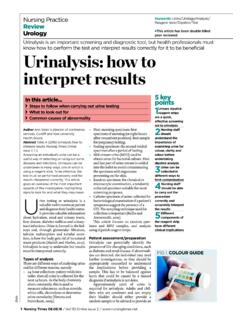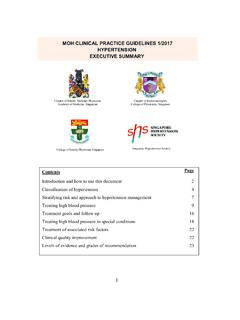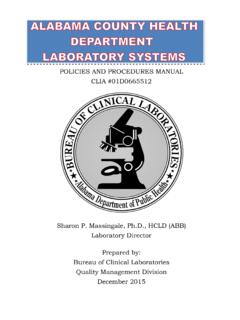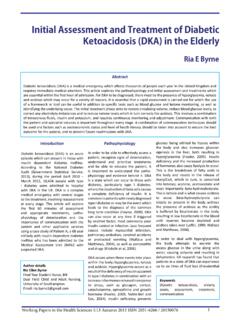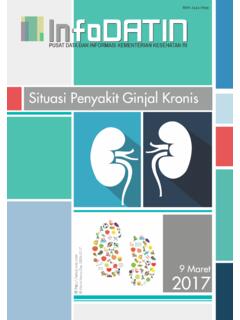Transcription of The Complete Urinalysis and Urine Tests - - RN.org®
1 The Complete Urinalysis and Urine Tests Reviewed April, 2018, Expires April, 2020 Provider Information and Specifics available on our Website Unauthorized Distribution Prohibited 2018 , , , LLC By Wanda Lockwood, RN, BA, MA The purpose of this course is to explain the components of the Urinalysis in detail and to explain the values and purposes of a wide range of urinary testing. Upon completion of this course, one should be able to: Describe the anatomy of the kidney and nephron and production of Urine . Explain 8 different types of Urine collection. Explain the significance of the components of a routine Urinalysis .
2 List reference values for routine Urinalysis . Explain at least 4 factors that can influence the color of Urine . Discuss at least 4 factors that can increase or decrease specific gravity. Discuss factors that affect acidity/alkalinity (pH) of Urine . Discuss the implications of glucose, ketones, nitrites, and leukocyte esterase in the Urine . List and discuss 6 Urine electrolyte Tests . Describe 6 types of sediment that may be found in Urine . List and describe at least 6 different associated Urine Tests . Introduction The urinary system comprises the kidneys, ureters, bladder, and urethra.
3 The kidneys filter unwanted waste materials from the blood and regulate the levels of water and chemicals in the body. The average adult cardiac output is about 1200 mL per minute, and about 25% of that is received by the kidneys per minute. About 99% of the fluid circulating through the kidneys is reabsorbed into the blood with the remaining excreted as Urine . Approximately 1000 liters of blood filtered through the kidneys produces one liter of Urine . Purpose Course objectives The nephron is the kidney's primary functional unit with each kidney containing approximately 1 million nephrons.
4 Nephrons are specialized coiled filtering tubules (about 1 inch in length) comprised of a glomerulus, Bowman s capsule, and a tubular system: Glomerulus: Twisted ball-shaped capillary network (tuft) surrounded by Bowman s capsule. Bowman s capsule: Double membrane cup-shaped structure that surrounds the glomerulus. Tubular system: Proximal convoluted tubule, loop of Henle (central area of nephron), and distal convoluted tubule. The cortex (outer layer) of the kidney is comprised of the glomeruli and Bowman s capsules as well as the proximal convoluted tubules and the ascending loops of Henle.
5 The medulla (central area) of the kidney contains the descending loops of Henle and distal convoluted tubules. [See CE course: Renal Function Tests .] In the absence of bladder or kidney infection, Urine is sterile until it reaches the urethra, which may be contaminated by bacteria. The Urine that is produced by the kidney is a by-product of some of the kidney s primary functions, which include: Waste excretion (urea, creatinine, drug metabolites, sulfates, uric acid). Maintaining electrolyte balance (such as sodium, chloride, potassium, and magnesium). For example, with normal kidney function 630 grams of sodium are filtered each day, grams are reabsorbed, and grams ( ) excreted in the Urine .
6 Acid excretion (products of protein breakdown), Water excretion/reabsorption, depending on fluid balance.. Urine comprises primarily: Water (95%). Urea. Chloride. Sodium. Potassium. Creatinine. Trace amounts of other ions, inorganic compounds, and organic compounds. The Urinalysis Hippocrates (430-377 BC) noted that the condition of Urine could reflect health. Through history, people created charts of Urine color to help diagnose disease and by the 17th century, practitioners began tasting Urine to help diagnose diabetes. Urinalysis has become more sophisticated since those times, but the Urinalysis remains one of the first Tests done for diagnosis of disease, especially diseases that may remain essentially silent until they are advanced.
7 The Urinalysis is a simple and noninvasive test that provides valuable information. Urinalysis is often done as part of a general health evaluation, but UA can also assist in the diagnosis or monitoring of a number of disorders or conditions: Systemic or metabolic diseases that affect kidney function (such as malaria and sarcoidosis). Endocrine disorders (such as diabetes mellitus). Kidney or urinary tract disorders (such as pyelonephritis, glomerulonephritis, and cystitis). Pregnancy. Drug abuse. A Urinalysis requires 3 types of examination: Direct observation to note color, odor, and consistency.
8 dipstick analysis : Tests include pH, specific gravity, protein, glucose, ketones, nitrite, and leukocyte esterase. Microscopic analysis : Sediment is examined for red blood cells, white blood cells, epithelial cells, casts, bacteria, yeast, and crystals, and other material (such as sperm and pinworm ova). Over the course of a 24-hour period, the composition and concentration of Urine changes continuously. For this reason, various types of specimens may be collected. Generally, about 10 mL of Urine is Types of Urine specimens required for routine Urinalysis . Urine specimens should be refrigerated if they cannot be examined within 2 hours because Urine begins to break down after that time, becoming more alkaline, and rendering some Urine Tests inaccurate.
9 Type of collection Discussion Random There are no particular precautions to avoid contamination. Single random specimens may be taken at any time of the day or night although usually the first voiding in the morning is discarded because the dehydration that occurs during the night may alter values. First morning specimen This is taken before ingestion of fluids. This sample is usually hypertonic and is done to evaluate the ability of the kidneys to concentrate Urine during the normal dehydration that occurs during sleep. Because early morning specimens tend to be more concentrated, some abnormalities may be easier to detect, and the specimen is generally free of dietary and exercises influences that may alter values.
10 Double-voided This is a specimen obtained after the first emptying of the bladder and waiting until a second voiding to collect the specimen. This is particularly useful for glucose as a specimen that has been maintained in the bladder for hours (such as overnight) may not accurately reflect glucose levels at the time the specimen is taken. Clean catch ( Midstream ) This is used for Urine culture and cytological analyses. It may also be used for routine Urinalysis in order to prevent contamination of the sample. It is obtained after cleansing about the urethral meatus with an antiseptic solution, such as benzalkonium hydrochloride.










